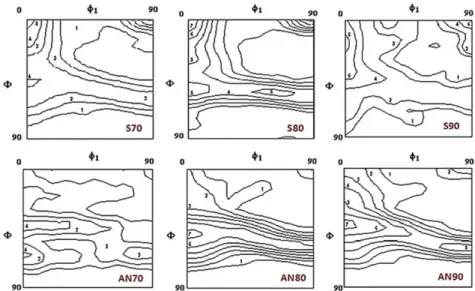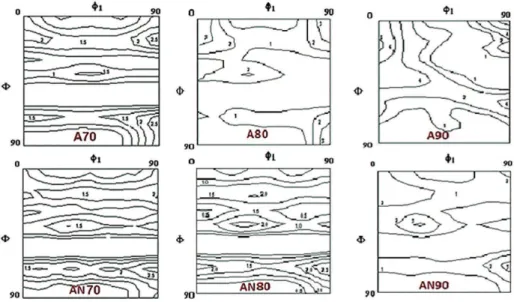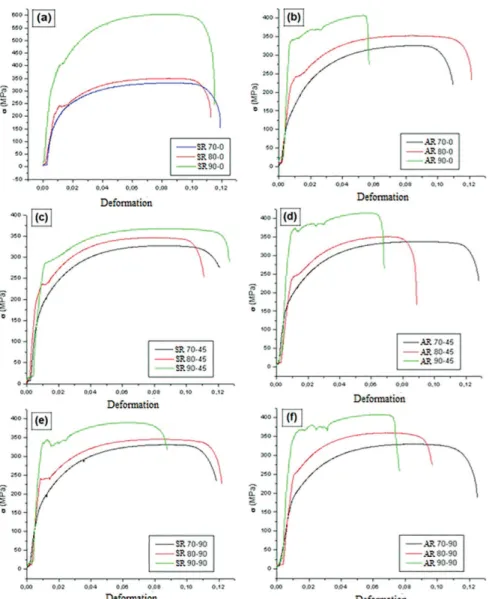Mechanical Properties and Crystallographic Texture of Symmetrical and Asymmetrical
Cold Rolled IF Steels
Nina do Amaral Sardinhaa, Igor Cuzzuol dos Santosa, Bárbara Vaz Andradea, Ramón Alves Botelhoa,
Rebeca Vieira de Oliveiraa, Saulo Brinco Diniza,b, Andersan dos Santos Paulaa, Luiz Paulo Brandaoa*
Received: August 7, 2015; Revised: June 26, 2016; Accepted: July 14, 2016
The crystallographic texture developed during cold rolling and subsequent annealing of interstitial
free sheet steels aims to increase conformability. For this, it is necessary to obtain partial α-iber and continuous and homogeneous γ-iber texture components. In this work, the inluence of symmetric
(SR) and asymmetric (AR) cold rolling on crystallographic texture and mechanical properties of an
interstitial free steel (IF) was investigated. Symmetric cold rolling yields α- and γ-ibers, which are enhanced as deformation increases. Moreover, α-iber weakening occurs due to recrystallizations, improving formability. The same ibers are produced by asymmetric cold rolling, but in this case, the γ-iber is slightly shifted in psi, which is one of Euler angles second ROE’s notation1,2, and more
homogeneous than in symmetric rolling. The best mechanical properties were achieved by asymmetric cold rolling/annealed with about 80% deformation.
Keywords: IF Steels, Asymmetrical Cold Rolling, Texture, Mechanical Properties, Symmetrical Cold Rolling, Formability
* e-mail: brandao@ime.eb.br
1. Introduction
Interstitial free steels (IF) are widely used in the
automotive industry3,4 thanks to their low tensile strength (100 to 350 MPa) and high formability. The industry tries to improve these properties even more, through appropriate thermomechanical processes such as cold rolling and annealing.
Cold rolling is one of the techniques used to obtain
preferred orientations in the material that will improve its
mechanical properties, especially the formability. Cold
rolling may be symmetrical or asymmetrical. In the irst
case, the rolls have the same diameter, the same speed and
the same friction coeicient. In the second, at least one of those conditions is diferent, leading to an additional shear strain, which may improve the mechanical properties and
the formability5.
By deinition, the normal anisotropy coeicient (rm or r)
is the planar average of r value, which is the ratio of the width strain (ln(w0/w) to the thickness strain (ln(t0/t) (r = ln(w0/w)/ ln(t0/t), obtained by a simple tensile test6. In this equation, w
0 and t0 are the initial sample width and thickness, respectively,
and w and t its width and thickness after about 15% of plastic
deformation. This parameter is generally used to verify the ability
of a sheet to undergo deep drawing. The larger this coeicient,
the better is the formability7,8. This can be seen in Equation (1),
where, r0, r45, r90 are r values obtained for samples removed 0,
45 and 90º degrees from the rolling direction and r is the normal
anisotropy coeicient.
aSeção de Engenharia Mecânica e de Materiais, Instituto Militar de Engenharia, Praça General
Tibúrcio, 80, 22290-270, Praia Vermelha, Rio de Janeiro, RJ, Brasil.
bCentro Federal de Educação Tecnológica Celso Suckow da Fonseca – CEFET, RJ, Angra dos Reis, RJ, Brasil
( )
r
=
r
0+
2
r
4
45+
r
901
In ultra-low carbon steels, the preferred orientations are located in two main ibers: α (<110>//Rolling Direction-RD) and γ (<111>//Normal Direction-ND)9, regardless of the rolling technique10. High formability is associated with
a high fraction of γ-ibers and a low fraction of α-ibers11.
If, r0, r45 and r90 exhibit signiicant diferences, the “earing phenomenon” can occur, due to the planar anisotropy (Dr)
condition described by Equation (2)12:
( )
r
r
0r
902
2
r
452
D
=
+
-The sheet formability is also influenced by the
hardening coefficient (n), which, using Hollomon equation13
(σ=Kεn), is the slope of the ln(σ) versus ln(ε) curves in the plastic regime and numerically equal to the uniform elongation. This parameter is important for forming operations, because it measures the hardening ability of the material, i.e., its ability to homogeneously distribute
deformation along the sheet surface before necking14.
This work aims to compare the efect of symmetrical
and asymmetrical cold rolling in the texture and mechanical
1043 Mechanical Properties and Crystallographic Texture of Symmetrical and Asymmetrical Cold Rolled IF Steels
2. Experimental Procedure
A hot-rolled IF steel with 4.9 mm thickness produced by Companhia Siderúrgica Nacional (CSN) – Brazil was used in this research. Its chemical composition (wt.%) was: 0.002 %C, 0.104 %Mn, 0.011 %P, 0.06 %Ti, 0.009 %S, 0.003 %Ni, 0.001 %Sn, 0.035 %Al, 0.004 %N,0.002 %Nb
and Fe is the balance.
Symmetrical (SR) and asymmetrical (AR) cold rolling were performed in a FENN MFG. Co, model D51710 Rolling Mill to 70, 80 and 90 % thickness reductions. The coniguration for SR was two mill rolls with 133.70 mm diameter each (duo coniguration). For the AR, upper and lower rolls with 40.18 mm and 31.72 mm diameter, respectively, were used. For analyzing the efect of annealing, after rolling, samples were annealed in a salt bath at 850 °C for 120 s and cooled in air. Finally, the samples were mechanical polished to half thickness and etched by a 5 % hydroluoric acid (HF) and 95 % peroxide (H2O2) solution for 20s.
The X-ray measurements were performed on a PANalytical, X’Pert PRO MRD difractometer using Co-Kα radiation and yielded (110), (200) and (211) pole igures. These experimental pole igures were processed with the help of popLA software and they are presented for 0o and 45º φ
2 sections using the Bunge notation.
In order to evaluate the mechanical properties of the annealed materials, 5 rectangular samples with dimensions of 15 x 100 mm, were cut for each processing condition, i.e., symmetric and asymmetric cold rolled followed by an 850ºC during 120 s annealing process, on three diferent angles with the rolling direction: 0°, 45° and 90°, totalizing 90 samples. The tensile tests were conducted on an EMIC DL 10000 machine with a 3mm/min loading rate, following the ABNT NBR 6892-115 standard, and the yield point (σ
e),
tensile strength (σm) were evaluated. The ABNT NBR 16282
16
was followed for rm, Dr and work hardening coeicient (n)
determinations. The highest and the lowest values of each measurement were discarded and the average of the others was taken as the inal result.
3. Results and Discussion
The φ2 = 45º sections of the Orientation Distribution
Function (ODF) for the symmetrical cold rolled and annealed samples are shown in Figure 1. α- and γ-ibers can be observed for 70, 80 and 90 % cold rolled samples. The volume fraction of α-ibers increases up to 90 % deformation, but the volume fraction of γ-ibers is smaller for 90 % deformation than for 80 % deformation. This may be related to the development of a new <110>//RD component, which inhibits the development of γ-ibers. The efect of annealing is to decrease the volume fraction of α-ibers and to increase the volume fraction of γ-ibers, thus increasing the formability of IF steels17. The
graphs of Figure 2 illustrate the development of α- and γ-ibers for all symmetrical cold rolled and annealed samples.
Since the deformation of asymmetrically rolled samples
is not homogenous over the sheet thickness, the texture was analyzed in three diferent sample positions: on the lower and upper surfaces and in the middle plane. Generally, the texture was the weakest in the lower surface and the strongest in the upper surface, where it was similar to that
of symmetrically rolled samples. For comparison, Figure
3 shows the φ2 = 45º ODF sections for the middle plane,
where no components are observed at Φ = 54.7º, the original position of the γ-iber. In this Figure 3, it can be seen the ODF sections for annealed 70, 80 and 90 % asymmetrically cold rolled samples. This is taken as evidence of a shift of
the position of the γ-iber, as reported by Tóth et al18. The
graphs of Figure 4 show the volume concentration of α- and γ-ibers in asymmetrically rolled samples, before and after annealing. It can be seen that the volume fractions of α- and γ-ibers are smaller than in symmetrically rolled samples and that annealing decreases the volume fraction of α-ibers and
thus increases formability.
Stress–strain curves of annealed symmetrically and asymmetrically cold rolled samples are shown in Figure 5. It can be observed that the yield (σe) and tensile (σm) strengths
increase with deformation for both symmetrically (SRXX-Y) and asymmetrically (ARXX-Y) rolled/annealed samples, where XX denotes the deformation degree and Y is the angle with which the sample was taken. Asymmetrical rolling yielded larger values of σeand σmvalues for all deformations and
angles, except for SR90-0 sample, whose σm was larger than
that of asymmetrically rolled/annealed samples.
The larger tensile strength (σm) of asymmetrically rolled
samples may be due to the fact that the larger shear stress
associated with asymmetrical deformation leads to grain breaking and, consequently, to a smaller grain size in the
rolled sample19. Wauthier et al.20 reported that this phenomenon
could be observed by EBSD. The values of σm and σe in this
work are larger than those reported by other authors21, 22.
As shown in Table 1, the work hardening coeicient n
decreases with increasing deformation, as might be expected
if deformation becomes more and more nonhomogeneous as
thickness reduction progresses. The decrease is approximately
linear and, in the case of asymmetric rolling, can be described
by Eq. 3, where %x is the percentage relative thickness
reduction and the coeicient of determination is 0.95.
.
.
%
( )
n
=
0 9741
-
0 0095
x
3
Table 2 shows the normal and planar anisotropy of the annealed samples. The values are lower than the expected
for this type of material23-25. The largest value of rmwas 1.45 for the SR90 samples. Annealed asymmetrically
Figure 1: ODF section of φ2 = 45º for IF steel samples symmetrically cold rolled (S) for 70, 80 and 90% and after annealing (AN).
1045 Mechanical Properties and Crystallographic Texture of Symmetrical and Asymmetrical Cold Rolled IF Steels
Figure 3: ODF section of φ2 = 45º for IF steel samples asymmetrically cold rolled (A) for 70, 80 and 90 % and annealed (AN).
Figure 5: Engineering stress vs strain curves of annealed symmetrically rolled samples, (a) 0º RD, (c) 45º RD, (e) 90º RD and annealed
asymmetrically rolled samples, (b) 0º RD, (d) 45º RD e (f) 90º RD.
Table 1: Work hardening coeicient (n) of annealed symmetrically and asymmetrically cold rolled samples.
Hardening coeicient (n)
Cold rolling (%) 70% 80% 90%
Rolling angle 0 45 90 0 45 90 0 45 90
Symmetric 0.318 0.302 0.301 0.245 0.236 0.211 0.252 0.182 0.153
Asymmetric 0.326 0.309 0.281 0.222 0.250 0.226 0.133 0.105 0.111
Table 2: Normal plastic anisotropy (r̅) and planar anisotropy (∆r)
of annealed symmetrically (SR) and asymmetrically cold rolled samples (AR).
Normal plastic anisotropy Planar anisotropy
SR 70 1.29 -0.45
SR 80 1.22 -0.26
SR 90 1.45 -0.39
AR 70 1.25 0.24
AR 80 0.99 0.21
AR 90 1.06 -0.28
For all annealed symmetrically cold rolled samples and for the AR90 sample (annealed asymmetrically ones) negative
values of planar anisotropy were found, while positive values were found for the AR70 and AR80 samples. The ideal planar anisotropy from the point of view of formability should be around zero, but the lowest value found in this work was 0.26 for AR80 sample. This Dr values indicates that deep
1047 Mechanical Properties and Crystallographic Texture of Symmetrical and Asymmetrical Cold Rolled IF Steels
4. Conclusions
The results of the present work lead to the following
conclusions:
(i) The symmetrically cold rolled and annealed samples
presented a typical texture of low carbon steels, consisting of partial α-ibers and continuous γ-ibers;
(ii) The volume fraction of γ-fibers increased with deformation up to a thickness reduction of 80 %. A decrease in the volume fraction of γ-fibers was observed for a 90 % thickness reduction, possibly due to the appearance of new <110>//RD components;
(iii) The texture induced by asymmetric rolling was
smaller than the texture induced by symmetric rolling, but
the volume fraction of α-ibers was considerably reduced
by annealing, thus increasing formability;
(iv) In the case of asymmetrically rolled/annealed samples, texture components were not found in the original position of γ-ibers, Φ = 54.7°, but ibers were formed between 60 < Φ < 75°, suggesting a displacement of γ-ibers;
(v) All deformations increased the values of the yield and strength stress; the largest increases of σe and σm were observed in asymmetrically rolled samples.
5. Acknowledgments
The authors would like to thank Companhia Siderúrgica Nacional (CSN) – Brazil, for providing the steel, Temperaço Rio – Brazil for performing the annealing treatments, CNPq and CAPES for financial supporting and Instituto Militar de Engenharia (IME)
for the use of its facilities.
6. References
1. Roe RJ. Description of crystallite orientation in polycrystalline materials: III. General solution to pole igure inversion. Journal of Applied Physics. 1965;36(6):2024-2031.
2. Davies GJ, Goodwill DJ, Kallend JS. Charts for analysing
crystallite orientation distribution function plots for cubic materials. Journal of Applied Crystallography. 1971;4:67-70.
3. Ray RK, Ghosh P, Bhattacharjee D. Efects of composition and
processing parameters on precipitation and texture formation
in microalloyed interstitial free high strength (IFHS) steels. Materials Science and Technology. 2009;25(9):1154-1167.
4. Banerjee K. Physical Metallurgy and Drawability of Extra Deep Drawing and Interstitial Free Steels. In: Sztwiertnia
K, ed. Recrystallization. Rijeka: InTech; 2012. [Acess 2014
set 16]. Available from: http://www.intechopen.com/books/
recrystallization/physical-metallurgy-and-drawability-of-ext a-deep-drawingand-interstitial-free-steels>. Access
in: 16/09/2014.
5. Ji YH, Park JJ. Development of severe plastic deformation by
various asymmetric rolling processes. Materials Science and Engineering: A. 2009;499(1-2):14-17.
6. Lankford WJ, Snyder SC, Bauscher JA. New Criteria for Predicting the Press Performance of Deep Drawing Sheets. Transactions of the American Society of Metals. 1950;42:1197-1232.
7. Hoile S. Processing and properties of mild interstitial free steels.
Materials Science and Technology. 2000;16(10):1079-1093. 8. Ray RK, Ghosh P. Texture in the design of advanced
steels. Transactions of the Indian Institute of Metals.
2013;66(5):641-653.
9. Urabe T, Jonas JJ. Modeling Texture Change during the Recrystallization of an IF Steel. ISIJ International. 1994;34(5):435-442.
10. Bunge HJ. Mathematische Methoden der Texturanalyse. Berlin:
Akademie-Verlag; 1969.
11. Ray RK, Jonas JJ, Hook RE. Cold rolling and annealing texture in low carbon and extra low carbon steels. International Materials Reviews. 1994;39(4):129-172.
12. Mishra S, Darmann C. Role and control of texture in deep-drawing steels. International Metals Reviews.
1982;27(1):307-320.
13. Hollomon JH. Tensile deformation. Transactions of the Metallurgical Society of AIME. 1945;162:268-290. 14. Antunes RA, Oliveira MCL. Materials selection for hot
stamped automotive body parts: An application of the Ashby approach based on the strain hardening exponent
and stacking fault energy of materials. Materials & Design.
2014;63:247-256.
15. Associação Brasileira de Normas Técnicas. NBR 6892-1 Materiais metálicos – Ensaio de Tração. Parte 1: Método de ensino à temperatura ambiente. Rio de Janeiro: ABNT; 2015.
16. Associação Brasileira de Normas Técnicas. NBR 16282 Folhas e chapas de aço de baixo carbono – Determinação da anisotropia plástica e do expoente de encruamento – Método de ensino. Rio de Janeiro: ABNT; 2014.
17. Saha R, Ray RK. Effect of Severe Cold Rolling and Annealing on the Development of Texture, Microstructure and Grain Boundary Character Distribution in an Interstitial Free (IF)
Steel. ISIJ International. 2008;48(7):976-983.
18. Tóth LS, Beausir B, Orlov D, Lapovok R, Haldar A. Analysis
of texture and R value variations in asymmetric rolling
of IF steel. Journal of Materials Processing Technology.
2012;212(2):509-515.
19. Lapovok R, Orlov D, Timokhina IB, Pougis A, Toth LS, Hodgson PD, et al. Asymetric Rolling of Interstitial-Free Steel Using One Idle Roll. Metallurgical and Materials Transactions A. 2012;43(4):1328-1340.
20. Wauthier A, Regle H, Formigoni J, Herman G. The effects of asymmetrical cold rolling on kinetics, grain size and texture in IF steels. Materials Characterization. 2009;60(2):90-95. 21. Humane MM, Minz RK, Paretkar RK, Peshwe DR. Effect of
cold rolling and mode of annealing on textures, mechanical properties and formability limit diagrams in interstitial free steel sheets. Transactions of the Indian Institute of Metals.
22. Meira RR. Efeito da variação das condições de encharque nas propriedades mecânicas do material IF processado no recozimento contínuo da Usiminas [Dissertation]. Belo Horizonte: Universidade Federal de Minas Gerais; 2006.
23. Banerjee K, Verma AK, Venugopalan T. Improvement of Drawability of Titanium-Stabilized Interstitial-Free Steel by Optimization of Process Parameters and Texture. Metallurgical and Materials Transactions A. 2008;39(6):1410-1425.
24. Ghosh P, Bhattacharya B, Ray RK. Comparative study
of precipitation behavior and texture formation in cold
rolled-batch annealed and cold rolled-continuous annealed
interstitial free high strength steels. Scripta Materialia.
2007;56(8):657-660.


